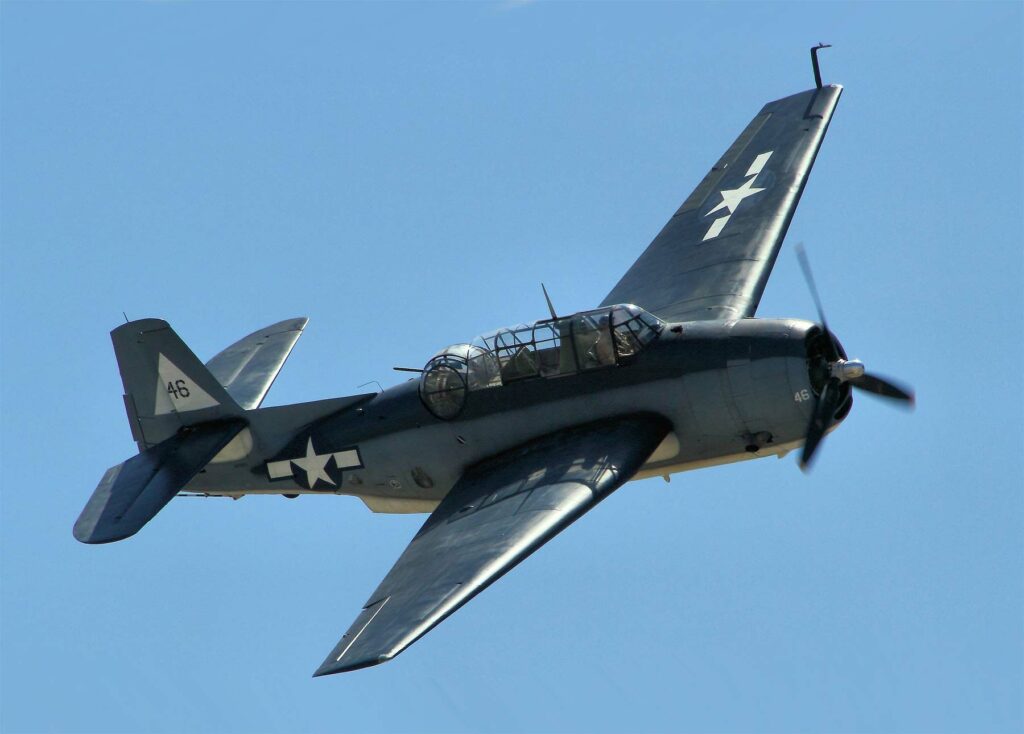The Grumman TBF Avenger, a WWII American torpedo bomber, known for its significant role in naval battles, robust design, and versatility.
The Grumman TBF Avenger was a key torpedo bomber in the U.S. Navy’s arsenal during World War II. Renowned for its contributions to crucial naval battles, the Avenger combined robustness, payload capacity, and versatility. This article delves into the development, design, operational capabilities, and combat history of the TBF Avenger.
History of the Development of the Grumman TBF Avenger
In the late 1930s, with global tensions rising, the U.S. Navy recognized the need for a modern torpedo bomber to replace the aging Douglas TBD Devastator. The development of the TBF Avenger was initiated by Grumman Aircraft Engineering Corporation, under the leadership of Leroy Grumman. The objective was to create an aircraft capable of delivering torpedoes and bombs effectively while withstanding the rigors of naval operations.
The first prototype of the Avenger flew on August 7, 1941. The development of the TBF Avenger was driven by the strategic requirements of naval warfare and the need for an aircraft that could operate from aircraft carriers and engage heavily fortified naval targets.
Its development was critical in enhancing the U.S. Navy’s offensive capabilities during a pivotal era in naval aviation.
Design of the Grumman TBF Avenger
The Avenger’s design was focused on functionality and durability. It featured a large internal bomb bay capable of carrying a torpedo or a significant bomb load. The aircraft was powered by a Wright R-2600 Twin Cyclone radial engine, providing a balance of power and reliability.
The Avenger had a length of 12.2 meters and a wingspan of 16.5 meters. Its design included a turret-mounted machine gun for defense and a crew of three: a pilot, a turret gunner, and a bombardier.
The design of the Avenger had some drawbacks, such as its size, which made it a larger target, and its relatively slower speed compared to fighter aircraft. However, its robust construction and load-carrying capacity made it an invaluable asset in naval operations.

Performance of the Grumman TBF Avenger
In performance terms, the Avenger was capable and reliable. It could reach a top speed of approximately 440 km/h (273 mph) and had a service ceiling of 7,300 meters (24,000 feet). Its range of about 1,700 kilometers (1,056 miles) allowed for extended missions over the ocean.
Compared to other contemporary torpedo bombers, like the Japanese Nakajima B5N, the Avenger was more heavily armed and armored, though it was not as fast. Its ability to withstand damage and carry a heavy payload made it effective in its role.
Military Use and Combat of the Grumman TBF Avenger
The Avenger was armed with torpedoes or bombs and machine guns for defense. It saw extensive use in the Pacific Theater, particularly in key battles such as Midway, the Philippine Sea, and Leyte Gulf. Its effectiveness in torpedo attacks and bombing runs was instrumental in several U.S. naval victories.
The Avenger’s impact in combat operations was significant, and it faced various enemy aircraft and anti-aircraft defenses. It was used by the U.S. Navy and Marines, as well as by other Allied forces during and after the war.
The TBF Avenger was eventually replaced by more advanced aircraft post-World War II, but its legacy as a robust and effective torpedo bomber endures.
The Grumman TBF Avenger stands as a significant contributor to Allied success in World War II, particularly in the Pacific. Its development, design, and operational use reflect the strategic importance of naval air power during the war. The Avenger’s legacy is characterized by its robustness, versatility, and effectiveness in changing the course of naval battles, marking it as one of the most important torpedo bombers of its time.
Back to the Bombers section.